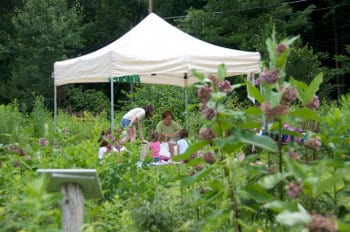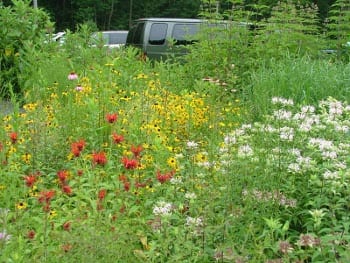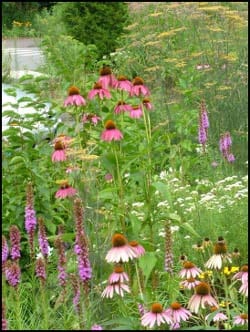by Margery Winters
To some of our visitors, the Marabeth Storrs Finn Native Plant Butterfly Garden at Roaring Brook Nature Center in Canton, CT, is more of a wild area than a garden. Perhaps this perception comes from how gardens have been traditionally defined as a plot of ground, usually near a house, where various plants are cultivated. Wikipedia’s definition of a garden as a planned space set aside for the display, cultivation, and enjoyment of plants and other forms of nature seems a much more suitable definition and goal for gardens, especially ours. Few gardens are as enjoyed by creatures of two, four, or more legs.
Located directly in front of the Nature Center building, this three-quarter-acre garden was begun in the spring of 2001 after the installation of a new septic system leach field provided a clean slate for a new garden. Conceived as a memorial to the sister of the founder of the Nature Center and funded through a grant from the Silvio Conte U.S. Fish & Wildlife Foundation, the garden was developed to demonstrate the beauty of our native plants in a garden setting. Christine Cook, a landscape architect associated with the Connecticut Butterfly Association, created the original plan for the garden with suggestions for native plantings that would appeal to caterpillar and butterfly alike.
From Inauspicious Beginnings
The garden’s beginning was not auspicious. The soil left by the contractor proved to be rock-hard subsoil, and the spring and summer of 2001 presented a prolonged and severe drought. Numerous local garden club and Nature Center volunteers dug in the new plants with a scoop of compost, a dash of water, as well as considerable doubt that the transplants would survive. A shallow well, the long distance from the hose, and a small staff precluded regular watering. The native plants proved their tenacity. Not only did the plants survive, they thrived.
Eleven years on, the garden has matured and evolved. Gardening with these native plants has been a lesson in relinquishing control and learning to adjust to the plants’ wishes. No domesticated, well-behaved garden plants, these plants have wills of their own. Over the years, the plants have located themselves where they are happiest. Some plants have thrived while others struggled and slowly disappeared. Plants that thrive have been divided and moved to new locations. Plants that do not tolerate transplanting have seeded themselves in new locations with abandon. Each year Nature Center staff and volunteers make pilgrimages to favorite native plant nurseries for new additions for the garden. And birds have planted a few of their favorites as well.
A Siren Song for Pollinators
Our native plants are adapted to the vagaries of Connecticut spring weather and are slower to emerge from the soil than many non-native garden plants. As a result, the Nature Center garden only really gets underway in mid-May when the plants practically explode from the ground. From June until mid-September the garden is in full bloom and is visited by a host of butterflies. Although each plant was chosen with a specific butterfly or butterfly larva in mind, it is the way that these native plants support other creatures throughout the year that really brings the garden to life.
Throughout the growing season, this garden is a haven for our less familiar pollinators: braconid wasps, chalcid wasps, mason bees, mining bees, green sweat bees, cuckoo bees, and bumblebees. Monarda didyma and monarda fistulosa are popular nectar and pollen sources, but these pollinator magnets pale in comparison to the mountain mints. In mid-July, the inconspicuous white flowers of the thin-leaved mountain mint are covered with the greatest assortment of wasps and bees so besotted with the flowers that they can be petted while they enjoy their meal.
A Home for Birds
Although planned as a butterfly garden, the butterfly season at the Nature Center is short. Caterpillars can be difficult to find and butterflies are highly weather dependent, preferring to visit on only the nicest of days when flowers are present. It is really the birds that enjoy this garden year-round. The two bluebird houses located in the garden are usually full of nestlings early April through midsummer. And with such an abundance of native caterpillars in the garden, the favorite food for many nestling birds, it is an ideal place for bluebirds to raise their young. As University of Delaware entomology professor Douglas Tallamy reports in his book, Bringing Nature Home, native shrubs support 35 times more caterpillar biomass than non-native shrubs. More abundant caterpillars make the task of raising young birds easier for the parent birds, resulting in more fledged birds. Areas with native shrubs have much greater total numbers of birds and even a greater diversity of bird species.
From early to late summer, shadblow, chokeberry, blueberry, spicebush, viburnum, bearberry, dogwood, and elderberry shrubs provide fruit for vast flocks of feathered visitors. A walk through the late summer/fall garden flushes creatures from every bush: fall migrating yellow-rumped warblers devouring ripe bayberries; American goldfinch relishing the seed heads of rudbeckia and purple coneflowers; sparrows balancing on the seed heads of the native grasses; rabbits, shrews and mice darting in and out of hiding places along the paths; squirrels and chipmunks harvesting the ripening American hazelnuts.
Welcoming for People
And this is also a garden enjoyed by our human visitors, especially the children. Although bordered by the busy road, our driveway and a parking lot, by mid-May to October the center of the garden is hidden from view by the lush growth and safely buffers our guests from cars. Mothers and their small children are often found picnicking there. The children race excitedly through the winding garden paths past the towering Joe Pye weed, chasing the silky parachutes of the milkweed seeds, rattling the dried baptisia seedpods as the blades of the little blue stem grasses brush their legs. Adults stroll more leisurely but experience a garden with much more vigor and life than the placid and relatively lifeless gardens that surround their homes. Many of our visitors ask for plant lists or transplants that they can take home to create their own native plant garden that they can enjoy.
The more plants we give away to interested visitors, the more we can convince local gardeners to tuck a few native plants into their garden, the better it is for our garden. No garden stands alone. The wildlife in our garden comes primarily from the surrounding woodlands with their native trees that are host plants to the larva of many of our butterfly visitors, as well as from other woodlands and meadows farther afield. In order for our visitors to enjoy monarch butterflies in this garden we need to rely on a network of milkweed plants from Mexico to Connecticut. Many of our birds require native plant food sources nearby or along their entire migration routes throughout the entire year. The native plants provide our native wildlife with just the right food, at just the right time of year.
A French Connection
Our gardens have great potential. An example of the possibilities comes from overseas. The Noé (Noah) Project in France is encouraging the thirteen million French gardeners to play an important role in the preservation of the beautiful, but increasingly rare, peacock butterfly. Many of the nature reserves in France are too few and far between to support the life cycle of these butterflies. The Noé Project observed, however, that gardens cover four times as many acres of land as the nature reserves in France. With the inclusion of certain native plants in many of these gardens, the peacock butterfly can be connected to the reserves and enjoy an expanded habitat.
Just imagine the enjoyment that our gardens could bring if we started to manage them as vital threads in the landscape tapestry. Perhaps by changing our perceptions of gardens to be more outward looking, purposely borrowing from, and connecting to, our native landscapes through the use of native plants, our gardens can become not only more lively and enjoyable to us, but to the many creatures with whom we share our gardens.
About the Author
Margery Winters is Assistant Director at Roaring Brook Nature Center and has been managing the Nature Center’s gardens since 2001. Margery served as Chairman of the Federated Garden Club of Connecticut Landscape Design Study Program and is a Master Landscape Design Consultant. She serves as Vice Chairman on Simsbury’s Conservation Commission, is a member the Simsbury Open Space Committee, and a board member of the Simsbury Land Trust. She may be reached at margerywinters@comcast.net.






